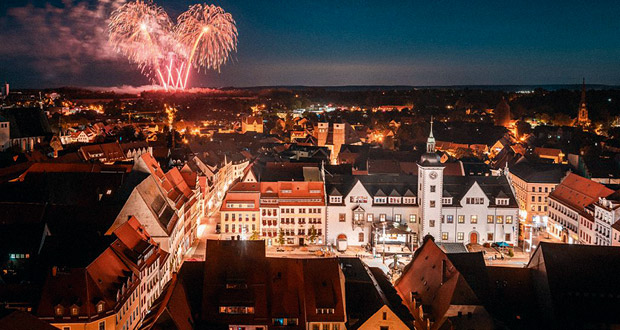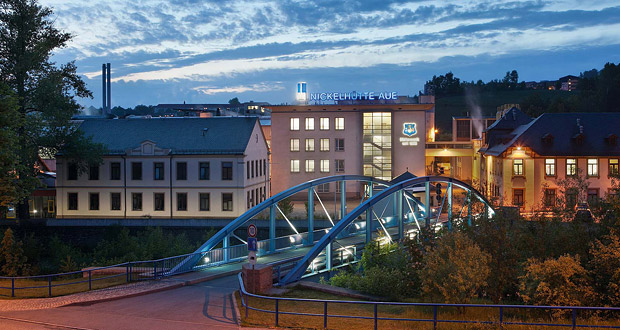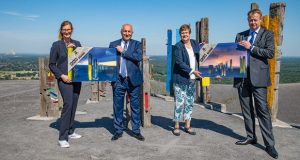During the naming of the Erzgebirge/Krušnohoří mountain region as a UNESCO World Heritage Site one year ago, it was said that “the Ore Mountains were the Silicon Valley of Saxony” (Figure 1). Not only was the work of the miners underground incredible, there were remarkable developments surrounding science, technology, infrastructure, supplier trade and associated industry within a short period of time along the mountain ridge. This is testament to the extraordinary endurance and a spirit of inventiveness that prevailed in the mountain region, and still dominates to this day.
The medium-sized companies based in the Ore Mountains continue to uphold these traditional values today through building up extensive production expertise in the industries associated with mining and finding individual solutions for specific applications. Little is usually known about their areas of application as the visibility of their products is limited. The work that goes on behind the scenes, as a supplier and niche provider, is also the reason why the Ore Mountains from the outside do not look like they are home to strong brands. But it is exactly the variety and heterogeneity of the economic region that have proven to be crisis-resistant and offer a special benefit. Very few other regions boast such a large number of production companies from so many different industries in such a small space. This is one reason why three innovation projects in the Ore Mountains are currently aiming to channel regional efforts into research and development in order to achieve visible success in cooperation. The SmartERZ, recomine and Smart Rail Connectivity Campus project proposals as part of the WIR! programme are perfect for the region. This is because these projects give the closely interlinked economic structure access to research institutes and the opportunity to build up partnerships over the long term. The coexistence of many different industries alone was a guarantee of success for the Ore Mountains as a mining region.
The secret of the region was the people of the Ore Mountains, both back then and today. Michael Urban, pioneer of the World Heritage project on the Czech side, goes one step further, describing the Ore Mountains as the Silicon Valley of the whole world (at that time). Residents of the Ore Mountains with experience of mining and the best academic background became sought-after experts, which is why the region attracted miners from all over the world and also sent workers to sites internationally. Besides people, the region – just like the Silicon Valley – needed the right conditions to make this work possible. The decisions made by electors, including those regarding minting rules and the awarding of minting rights to Annaberg and Joachim’s Valley in the early 16th century, the founding of a mining university in 1765/66, and the extension of trade routes, established essential conditions that enabled the coal and steel industry to continuously develop. Universal scholars and researchers who helped pave the way for current science include names from the Ore Mountains, such as Alexander von Humboldt, Novalis, Adam-Ries, Georgius Agricola and Carl von Carlowitz.
Economic funding works in a similar way today. Site requirements cannot be avoided but can be worked around through intelligent approaches in conjunction with the fields of politics, science and society in order to give ambitious visionaries and decision-makers an opportunity. Innovation is not an end in itself but rather serves to optimise the status quo. Water pumping techniques were improved with horizontal reciprocating rods and the reversible waterwheel in Joachim’s Valley and Ehrenfriedersdorf in the 16th century in order to be able to mine deeper ores. The unit with curved journal developed by Heinrich Eschen-bach was instrumental in the design of pump systems for centuries. Similarly crucial issues exist today for the mobility of the 21st century. Setting the course for the Smart Rail Connectivity Campus can increase the potential to further develop the region if future rail transport is incorporated to a significant degree at this site.
Sigismund von Maltitz from Dippoldiswalde took on a pioneering role with new ore dressing technologies that made it possible to separate ore into useful and waste components for the first time. This resulted in lower levels of dust pollution. Current issues surrounding the conservation of resources, sustainability and the recycling of contaminated sites to transform them into sources of raw materials are the subject of the recomine project. Nickelhütte Aue, among others, has been involved from the very outset. With a company history going back almost 400 years and over 400 employees, the Nickelhütte is an industrial heavyweight in the Ore Mountains (Figure 2).
The metallurgical and smelting business began its history as a blue dye factory. Nowadays the company is an expert in metal recycling. Its core business is the recycling of lithium-ion batteries – an important aspect in making the economy more environmentally friendly. Innovative technologies and material developments that have to at some point find their way back into the cycle are continuously giving rise to new fields of work.
New materials are the key word. In the last few centuries, in the same way that new alloys have resulted in different materials starting from the first discovery of silver, the people of the Ore Mountains are still working on the revolution of materials to this day, in order to give things functions. The extensive SmartERZ network develops approaches for interdisciplinary collaboration that are necessary for the product development of intelligent composite materials. Expertise in electrical engineering, plastic, textiles and metal is required, as well as mechanical engineers and plant developers who bring together these components. And the Ore Mountains offer exactly this versatility. (Ore Mountains Business Development/Si.)




